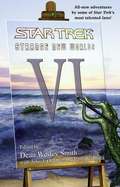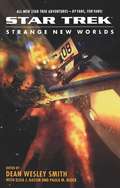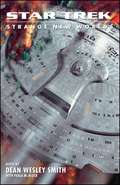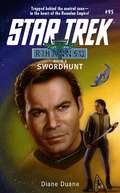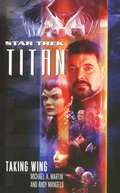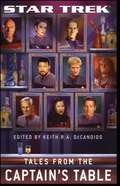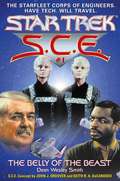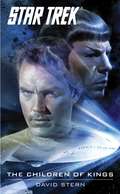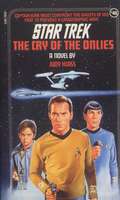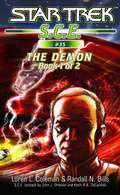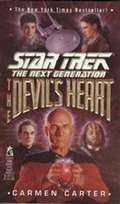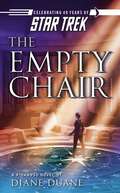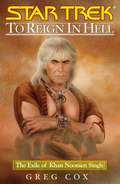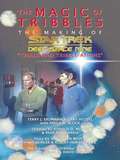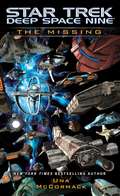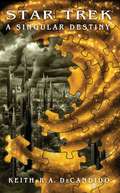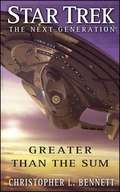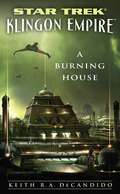- Table View
- List View
Star Trek: Strange New Worlds VI
by Dean Wesley Smith John J. Ordover Paula M. BlockIn the sixth year of its ongoing mission, the Strange New Worlds writing competition has once again sought out exciting new voices and imaginations among Star Trek's vast galaxy of fans. After scanning countless submissions for signs of style and originality, the judges are proud to report that the universe of amazing Star Trek writers just keeps expanding. Strange New Worlds VI features twenty-three never-before-published stories spanning the twenty-second to the twenty-fourth centuries, from the early days of Captain Jonathan Archer to James T. Kirk and his crew to the later generations of Captains Picard, Sisko, and Janeway. These memorable new tales explore and examine the past and future of Star Trek from many different perspectives. This year's contributors include such diverse life-forms as Julie Hyzy, Shane Zeranski, Penny A. Proctor, TG Theodore, Mark Allen, Charity Zegers, Juanita Nolte, G. Wood, Pat Detmer, Robert J. Mendenhall, Geoffrey Thorne, Russ Crossley, Louisa M. Swann, Scott W. Carter, Shawn Michael Scott, Brett Hudgins, Robert J. LaBaff, Paul J. Kaplan, Jan Stevens, Kevin Andrew Hosey, Elizabeth A. Dunham, Mary Scott-Wiecek, Robert T. Jeschonek, and Annie Reed. Join Strange New Worlds in its thrilling quest to uncover the most compelling Star Trek fiction this side of the Galactic Barrier!
Star Trek: Strange New Worlds VIII
by Dean Wesley Smith Paula M. Block Elisa J. KassinThis newest volume of Strange New Worlds features original Star Trek®, Star Trek: The Next Generation ®, Star Trek: Deep Space Nine®, Star Trek: Voyager®, and Star Trek: Enterprise™ stories written by Star Trek fans, for Star Trek fans! Each of these stories features our favorite Trek characters in new and adventurous situations. In this anthology, we get to experience a new version of the Kobayashi Maru, feel what it's like to be inside the Borg collective, delight in tasting new foods, and encourage Starfleet's future. This year's Strange New Worlds winners encompass newcomers and veterans alike, including Alan James Garbers, Kevin Lauderdale, Kevin Andrew Hosey, Paul C. Tseng, Kevin G. Summers, Sarah A. Seaborne, John Takis, Dan C. Duval, Amy Vincent, David DeLee, Muri McCage, Susan S. McCrackin, M.C. Demarco, Annie Reed, Amy Sisson, J.B. Stevens, Robert Burke Richardson, Lorraine Anderson, A. Rhea King, Derrek Tyler Attico, Geoffrey Thorne, and Paul J. Kaplan.
Star Trek: Strange New Worlds X
by Dean Wesley SmithAmbassador Sarek meets his future wife. Captain Ransom atones for his sins. T'Pol pursues a composer, after she is captivated by the human's music. Strands of DNA are woven together from four Starfleet captains, creating one man with one mission. An entity fights for its right to live, despite the fact that it is not alive. From the ordinary to the extraordinary, all of these stories are embraced by the vision of Star Trek®. When Gene Roddenberry created Star Trek, he also tapped a wellspring of human imagination. Viewers were transformed into fans, who embraced the show and turned the definition of "fan" on its ear. However, when what was on the screen was simply not enough, fans started writing their own stories, which they then shared among friends and family. Ten years ago, Pocket Books offered Star Trek fans a unique opportunity to become a part of the Star Trek mythos. A contest was created in which the best stories submitted by nonprofessional writers would be published. And over the course of a decade, hundreds of pounds of submissions poured in. Many of the writers who submitted to Strange New Worlds went on to become professional writers. This time there are nineteen writers: Rigel Ailur, David DeLee, M.C. DeMarco, Rick Dickson, Louis E. Doggett, Aimee Ford Foster, Edgar Governo, Robyn Sullivent Gries, Jim Johnson, Gerri Leen, Muri McCage, Brian Seidman, Randy Tatano, Paul C. Tseng, Rob Vagle, Laura Ware, Carolyn Winifred, Jerry M. Wolfe, and Jeremy Yoder. We welcome them to the book that is by the fans, for the fans.
Star Trek: Strange New Worlds: Asylum (Star Trek: Strange New Worlds)
by Una McCormackA new Star Trek adventure based on the thrilling Paramount+ TV series Star Trek: Strange New Worlds! When Una Chin-Riley and Christopher Pike meet at Starfleet Academy after one of his lectures, they immediately become friends. A stellar student, Una is the &“poster girl&” of her class, and Pike is determined to become a Starfleet captain with his own ship, rhetorically assembling his dream crew. As their friendship evolves, Pike also suspects Una is involved with the Euxhana, a Chionian cultural minority, who are seeking asylum in Federation space, leading to more questions than answers. Twenty-five years later, Una and Pike are working together on the USS Enterprise to settle a Chionian trade agreement when a pro-Euxhana saboteur launches a terrorist attack. When the suspect is taken into custody for interrogation and is discovered to have a history with Una, her past associations resurface, threatening to expose a secret she&’s been harboring all these years…
Star Trek: Strange New Worlds: Ring of Fire (Star Trek: Strange New Worlds)
by David MackA new adventure based on the thrilling Paramount+ TV series Star Trek: Strange New Worlds!When murder and sabotage imperil the time-sensitive and top-secret mission of a team of civilian scientists, Starfleet deploys Captain Christopher Pike and the Enterprise crew to Kathara Station, a classified research facility located above the accretion disk of a black hole. Lieutenant Commander Una Chin-Riley soon discovers the station&’s director, Valkeya, is hiding secrets—but so is Captain Pike, who many years earlier visited this same black hole on a mission that went tragically wrong, and whose consequences have haunted him ever since. Caught in the crossfire on the station are Science Officer Spock, Nurse Christine Chapel, and Security Chief La&’An Noonien-Singh, whose romantic entanglements old and new threaten to unravel their bonds of friendship. As enemies converge upon the station, can Valkeya and Pike both atone for the mistakes of their pasts in time to avert a tragedy? With time running out, the survival of Kathara Station, the USS Enterprise, and dozens of innocent lives hinges on their acts of contrition…
Star Trek: Strange New Worlds: The High Country (Star Trek: Strange New Worlds)
by John Jackson MillerThe first novel based on the thrilling Paramount+ TV series Star Trek: Strange New Worlds!When an experimental shuttlecraft fails, Captain Christopher Pike suspects a mechanical malfunction—only to discover the very principles on which Starfleet bases its technology have simply stopped functioning. He and his crewmates are forced to abandon ship in a dangerous maneuver that scatters their party across the strangest new world they&’ve ever encountered. First Officer Una Chin-Riley finds herself fighting to survive an untamed wilderness where dangers lurk at every turn. Young cadet Nyota Uhura struggles in a volcanic wasteland where things are not as they seem. Science Officer Spock is missing altogether. And Pike gets the chance to fulfill a childhood dream: to live the life of a cowboy in a world where the tools of the twenty-third century are of no use. Yet even in the saddle, Pike is still very much a starship captain, with all the responsibilities that entails. Setting out to find his crewmates, he encounters a surprising face from his past—and discovers that one people&’s utopia might be someone else&’s purgatory. He must lead an exodus—or risk a calamity of galactic proportions that even the Starship Enterprise is powerless to stop...
Star Trek: Strange New Worlds: Toward the Night (Star Trek: Strange New Worlds)
by James SwallowA thrilling new novel based on the Paramount+ TV series Star Trek: Strange New Worlds!While patrolling the borders of the Klingon Empire, Captain Christopher Pike and the crew of the USS Enterprise record a series of subspace echoes from a planet orbiting a volatile flare star—and when Lieutenant Spock and Commander Una Chin-Riley lead a landing party to learn more, they discover the ruins of a dead civilization and evidence of starship-grade metals…quite possibly a crash site. As they continue to investigate the strange signals, Spock and Una find shocking signs of dangerous alien life and remnants of what can only be Federation hardware. The trail soon leads Pike and Enterprise&’s helmswoman Lieutenant Erica Ortegas deep into the mystery of a lost Starfleet vessel, missing in action for over ninety years—and to a terrible dilemma that will challenge the crew to question their past...and their future.
Star Trek: Swordhunt (Star Trek: Vanguard #95)
by Diane DuaneThe sword was the ultimate symbol of Romulan power, tradition, and pride. It lay in the Senate Chamber of the Romulan Star Empire, revered and untouched for centuries, until the day Dr. Leonard McCoy was tried for treason -- and both were stolen during a daring attack on Romulus itself. Now, to avenge that insult and save face in the eyes of their deadly enemies, the Empire must recover the sword at any cost. Their envoys to the Federation demand the return of the sword and the extradition of the Romulan renegades who aided the Starship Enterprise in McCoy's escape. If diplomacy fails, the Romulans will trap the Klingons and the Federation in open war. In such dangerous times, the Starship Enterprise is assigned the most valuable -- and volatile -- element of all: the fugitive Ael, her stolen Bird-of-Prey Bloodwing, and the sword they carry. Ael will undoubtedly attempt to use ship and sword to foil her enemies and play her hand in the dangerous game that she's begun. But she will do it all under the watchful eyes of James T. Kirk, the Federation starship captain who knows her dangerously well...
Star Trek: Taking Wing (Star Trek: The Next Generation #Bk. 1)
by Andy Mangels Michael A. MartinAfter almost a decade of strife against foes such as the Borg, the Cardassians, the Klingons, and the Dominion, the United Federation of Planets is at the dawn of a new era. Starfleet is renewing its mission of peaceful exploration, diplomacy, and the expansion of knowledge. Among the starships spearheading that endeavor is the U.S.S. Titan, commanded by Captain William T. Riker and manned by the most biologically varied and culturally diverse crew in Starfleet history. But their mission does not begin according to plan. In the wake of Star Trek ® Nemesis, Praetor Shinzon, slayer of the Romulan Senate, is dead. The power vacuum created by his demise has put theRomulan Star Empire, longtime adversary of the Federation, at the brink of civil war. Competing factions now vie for control of their fragmenting civilization, and if the empire should fall, that entire area of the galaxy may destabilize. To restore order to the region, Titan 's long-anticipated mission of exploration is delayed as Starfleet assigns Riker to set up power-sharing talks among the Romulan factions. But even as the first tentative steps are takentoward building a new Romulus, the remnants of the Tal Shiar, the dreaded Romulan intelligence service, are regrouping behind the scenes for a power play of their own. With no other help available, Riker and the Titan crewbecome the last hope to prevent the quadrant from falling into chaos.
Star Trek: Tales from the Captain's Table (Star Trek)
by Keith R. A. DeCandidoTop Star Trek authors present thrilling stories about the pantheon of captains in this follow-up to the bestselling Captain&’s Table series.At the exclusive Captain&’s Table bar, nine Star Trek shipmasters share compelling tales of adventure, romance, tragedy, and duty from their careers in Starfleet. From Jonathan Archer to Kira Nerys, Will Riker, and more, these stories make up an unputdownable anthology.
Star Trek: The Art of the Deal
by Glenn GreenbergSTARFLEET CORPS OF ENGINEERS The U.S.S. da Vinci is sent to Vemlar to aid in the construction of a new research-and-development facility, run by an interstellar business tycoon named Rod Portlyn. But there is more to Portlyn's business dealings than meet the eye, as a group called Taru Bolivar is trying to sabotage the Vemlar project. Soon the combined crews of the da Vinci and the Starship Enterprise find themselves embroiled in a conflict that may lead to disaster! THE ART OF THE DEAL
Star Trek: The Belly of the Beast (Star Trek: Starfleet Corps of Engineers #1)
by Dean Wesley SmithWhen ancient alien technology is found on a colony world, when robot soldiers from an eons-old interstellar battle restart their war in a highly populated sector, when a global computer system starts to break down or take over, in goes the Starfleet Corps of Engineers. Overseen by Captain Montgomery Scott from his office at Starfleet Headquarters, the S.C.E. can build, rebuild, program, reprogram, assemble, reassemble, or just figure out everything from alien replicators to to doomsday machines. Just don't expect them to perform miracles -- unless they have to. The U.S.S. Enterpriseè has defeated a gigantic marauding starship from parts unknown. Now that the immediate threat has been neutralized, the S.C.E. has been called in to probe the vanquished hulk in search of both new technology and the secret of its origin. Lieutenant Commander Geordi La Forge has temporarily transferred from the Enterprise to assist Captain David Gold and the crew of the S.C.E. ship, the U.S.S. da Vinci, on this fascinating mission. La Forge works with Gold and his top-of-the-line group of technical specialists to unravel the high-tech mysteries of the supposedly dead alien vessel, only to discover that the real danger has just begun!
Star Trek: The Children of Kings (Star Trek: The Original Series)
by David SternA distress call goes out from a Federation outpost near the Klingon border. The U.S.S. Enterprise, under the command of Captain Christopher Pike, responds. Starbase 18 lies in ruin. There are no survivors. And there is no clue as to who is responsible for the attack, until Captain Pike’s brilliant science officer discovers a means of retrieving parts of the station’s log. Lieutenant Spock has detected signs of a unique energy signature, one that he believes is Klingon. There are unsubstantiated reports that the Klingon Empire has made a technological leap forward and created a cloaking device—code-named Black Snow Seven—that can shield their ships from even the most advanced sensors. The destruction of the base and the unique energy signature that remains prove that the Empire has succeeded. For generations the Orions have been known as pirates,operating at the margins, outside of legal conventions. A proud and powerful race, the Orions were once a major force in the sector, and they have been using the tension between the Klingon Empire and the Federation to rebuild their power. Captain Pike is charged with trying to foster cooperation between the Orions and the Federation. A distress call from an Orion vessel offers him the perfect opportunity. But the Orion ship lies in disputed space long claimed by the Klingon Empire, and crossing it could be the spark that sets off an interstellar war.
Star Trek: The Cleanup (Star Trek: Starfleet Corps of Engineers #60)
by Robert T. JeschonekSTARFLEET CORPS OF ENGINEERS During the Dominion War, the Miradorn -- ninety percent of whom are telepathically linked twins -- allied themselves with the Dominion. Now, in the wake of the Alpha Quadrant's victory in that war, the Miradorn are eager to improve their relationship with the Federation -- especially in light of the numerous dangerous devices the Dominion left behind. One of them has killed a Miradorn scientist named Or-Lin. Now, the S.C.E. team on the U.S.S. da Vinci must deactivate the rest of the devices before they become responsible for wiping out the entire Miradorn species -- but the only one who can help them is Or-Lin's twin, Em-Lin, who is still devastated by the death of her sister....
Star Trek: The Cry of the Onlies
by Judy KlassThe Cry Of The Onlines Boaco Six -- a once-tranquil Federation colony, now caught up in the throes of revolution. The Enterprise's mission: re-establish contact with the planet, and determine whether or not formal ties between the Federation and Boaco Six Should be strengthened. Negotiations beteween Captain Kirk and the planet's ruling Council of Youngers are proceeding smoothy, until the atmosphere of goodwill is shattered by the sudden destruction of a Boacan -- at the hands of an experimental Starfleet vessel! Now, in order to prevent full-scale war from breaking out, the Enterprise must recapute the stolen Starfleet vessel and its abductors. A mission that will require the aid of the galaxy's most reclusive genius -- and bring Captain Kirk face-to-face with the long-buried secrets of his past...
Star Trek: The Demon Book 1 (Star Trek: Starfleet Corps of Engineers #35)
by Randall N. Bills Loren ColemanSTARFLEET CORPS OF ENGINEERS What begins as a simple investigation of a peculiar subspace signal leads to an errand of mercy, as the da Vinci responds to a distress call -- from the edge of a black hole! Hundreds of years ago, the Resaurians placed a station near the event horizon, forever teetering on the edge of the abyss, and now the S.C.E. must find a way to rescue them. But the black hole, known as "the Demon," contains centuries-old secrets that the Resaurians will kill to protect -- and both the U.S.S. da Vinci and the station may be sacrificed to the Demon in order to preserve those secrets! THE DEMON Book 1 of 2
Star Trek: The Devil's Heart (The Next Generation)
by Carter CarmenThe Devil's Heart -- a legendary object of unsurpassed power and mystery. Worlds that believe in magic consider it Darkness's mightiest talisman; worlds of science consider it a lost artifact of some ancient and forgotten race. Some say the Heart enables its possessor to control people's minds and to amass wealth enough for a dozen lifetimes, while others thing it capable of raising the dead, perhaps even changing the flow of time itself. But to all, the location of this fabled object has remained a mystery -- until now. An isolated archaeological outpost has suddenly stopped responding to repeated requests for information. Sent to discover why, the U.S.S. Enterprise crew finds a devastated outpost and a dying scientist, whose last worlds fall on disbelieving ears: the Devil's Heart has been found. Now, as the quest for the Heart unfolds, Captain Jean-Luc Picard discovers the awful truth behind all the legends and age-old secrets: Whoever holds the Devil's Heart possesses power beyond imagining...
Star Trek: The Empty Chair (Star Trek: Vanguard )
by Diane DuaneTHE CULMINATION OF A SAGA TWENTY-TWO YEARS IN THE MAKING. They call themselves Rihannsu -- the Declared. To the Federation, they are the Romulans. By any name they are adversaries as formidable as they are inscrutable. Self-exiled from Vulcan in ages past, they retain an ancient martial philosophy and a code of conduct that has sustained them through centuries of hardship, warfare, and thwarted ambition. Now their empire is gearing for war once again. Armed with the revolutionary Sunseed technology, which can destabilize entire stars, a Romulan vessel is warping toward the heart of the Federation. Its target: Earth's sun. But this offensive comes at a perilous time, as a growing number of Romulan worlds are joining a revolution -- one led by the renegade Commander Ael t'Rllaillieu of the warbird Bloodwing, with the aid of Captain James T. Kirk of the Starship Enterprise™ and the Hamalki physicist K's't'lk, the Federation's foremost authority on Sunseed technology. As the threat to Earth looms ever larger, Bloodwing and Enterprise lead an armada toward the Romulan homeworld for a final reckoning that will decide the future of the Rihannsu people.
Star Trek: The Exile Of Khan Noonien Singh (Star Trek #3)
by Greg CoxAt last -- the untold chapter in the history of Star Trek's most notorious villain, KHAN. Searing and powerful, To Reign in Hell masterfully bridges the time period between Khan Noonien Singh's twenty-third-century revival in the Original Series classic episode "Space Seed" and his unforgettable return in the acclaimed feature film Star Trek II:The Wrath of Khan. What truly transpired during Khan's long years of exile on the forbidding world of Ceti Alpha V, before the tyrant escaped to embark on a murderous campaign of vengeance against Admiral James T. Kirk? What horrific trials spawned Khan's insane lust for revenge? Haunted by the memory of Khan's bitter accusations, Kirk now revisits Ceti Alpha V to discover for himself what ultimately drove Khan to madness. There, buried beneath the desolate surface of a dying planet, Kirk and his allies find the untold story of their greatest foe -- and of the woman who loved him: Lieutenant Marla McIvers of StarfleetŠ. Along with Khan's genetically engineered followers from the twentieth century, Khan and Marla are left on Ceti Alpha V with the hopes of building a new life together. Although the planet is savage and untamed, full of deadly predators and unexpected hazards, Khan dreams of carving out an empire even greater than the one he once ruled on Earth. But when catastrophe strikes, laying waste to the entire world, Khan and the others find themselves trapped in a desperate struggle for survival. Now Khan must use every ounce of his superhuman strength and intellect to wage a fearsome battle against the planet, his people...and the growing darkness in his own soul.
Star Trek: The Magic of Tribbles
by Terry J. Erdmann Paula M. Block Gary HutzelOriginally conceived of more than thirty-five years ago, these dimunitive creatures have become stars in their own right. With uncanny grace and ease they have won hearts and upstaged stars. They are tribbles. When the writers of Star Trek: Deep Space Nine were looking for the perfect episode ith which their characters could pay homage and interact with the crew from the original Star Trek , "The Trouble with Tribbles" instantly came to mind. Here is the story of how the wizards of Star Trek were able to create the magic that enabled -- with nothing more than countless hours of work -- ordinary actors to time-travel. This is the story behind the creation of the episode "Trials and Tribble-ations." This is The Magic of Tribbles.
Star Trek: The Missing (Star Trek)
by Una MccormackAn original novel set in the universe of Star Trek: Deep Space Nine--a direct sequel to the New York Times bestselling story arc, The Fall!The entire sector is waiting to see what the newly reopened Bajoran wormhole will mean for the shifting political landscape in the Alpha Quadrant. On Deep Space 9, Captain Ro Laren is suddenly drawn into the affairs of the People of the Open Sky, who have come to the station in search of sanctuary. Despite the opposition of the station's security officer, Jefferson Blackmer, Ro Laren and Deep Space 9's new CMO, Doctor Beverly Crusher, offer the People aid. But when Dr. Crusher's highly secure files are accessed without permission--the same files that hold the secrets of the Shedai, a race whose powerful but half-understood scientific secrets solved the Andorian catastrophe--the People seem the likeliest suspects.As tensions rise on the station, the science vessel Athene Donald arrives as part of its journey of exploration. The brainchild of Doctor Katherine Pulaski, this ship is crewed by different species from the Khitomer Accords and the Typhon Pact. Pulaski's hope is that science will do what diplomacy has not: help the great powers put aside their hostilities and work together. But when the Athene Donald is summarily stopped in her voyage by the powerful vessel of a hitherto unknown species, Pulaski begins to wonder--will this first contact bring her crew together or tear them all apart?TM, ®, & © 2014 CBS Studios, Inc. STAR TREK and related marks are trademarks of CBS Studios, Inc. All Rights Reserved.
Star Trek: The Next Generation: A Singular Destiny (Star Trek: The Next Generation)
by Keith R. DeCandidoThe powerful follow-up to the Star Trek: Destiny explores the consequences of the shattering events that have reshaped the universe. In the uneasy weeks after the events of Star Trek: Destiny #3: Lost Souls, the survivors of the holocaust continue to be tested to the limits of their endurance. But strange and mysterious occurrences are destabilizing the galaxy&’s battle-weary Allies even further. In the Federation, efforts to replenish diminished resources and give succor to millions of evacuees are thwarted at every turn. On the borders of the battered Klingon Empire, the devious Kinshaya sense weakness and opportunity. In Romulan space, the already-fractured empire is dangerously close to civil war. Sonek Pran—teacher, diplomat, and sometime adviser to the Federation president—perceives a pattern in the seeming randomness. And as each new piece of evidence falls into place, a disturbing picture encompassing half the galaxy begins to take shape...revealing a challenge to the Federation and its allies utterly unlike anything they have faced before.
Star Trek: The Next Generation: Before Dishonor (Star Trek: The Next Generation)
by Peter DavidAn enemy so intractable that it cannot be reasoned with. The entire race thinks with one mind and strives toward one purpose: to add our biological distinctiveness to their own and wipe out individuality, to make every living thing Borg. In over two centuries, the Federation has never encountered a greater threat. Twice Starfleet assembled and threw countless starships to stand against them. The Borg were stopped, the price paid in blood. Humanity breathed a sigh of relief, assuming it was safe. And with the destruction of the transwarp conduits, the Federation believed that the killing blow had finally been struck against the Borg. Driven to the point of extinction, the Borg continue to fight for their very existence, for their culture. They will not be denied. They must not be stopped. The old rules and assumptions regarding how the Collective should act have been dismissed. Now the Borg kill first, assimilate later. When the Enterprise manages to thwart them once again, the Borg turn inward. The dark places that even the drones never realized existed are turned outward against the enemy they have never been able to defeat. What is revealed is the thing that no one believed the Borg could do.
Star Trek: The Next Generation: Greater than the Sum (Star Trek: The Next Generation)
by Christopher L. BennettThe Starship Rhea has discovered a cluster of carbon planets that seems to be the source of the quantum energies rippling through a section of space. A landing party finds unusual life-forms inhabiting one of the planets. One officer, Lieutenant T'Ryssa Chen -- a half-Vulcan -- makes a tenuous connection with them. But before any progress can be made, the Rhea comes under attack from the Einstein -- a Starfleet vessel now controlled by the Borg. The landing party can only listen in horror as their comrades are assimilated. The Borg descend to the planet, and just as Chen accepts that she will be assimilated, the lieutenant is whisked two thousand light-years away. A quantum slipstream -- instantaneous transportation -- is controlled by these beings in the cluster, and in the heart of the cluster there is now a Borg ship. Cut off from the rest of the Borg collective, the Einstein cannot be allowed to rejoin it. For the sake of humanity, the Borg cannot gain access to quantum slipstream technology. Starfleet Command gives Captain Picard carte blanche: do whatever he must to help the beings in the cluster, and stop the Einstein no matter the cost.
Star Trek: The Next Generation: Klingon Empire: A Burning House (Star Trek: The Next Generation)
by Keith R. DeCandidoThey have been the Federation's staunchest allies, and its fiercest adversaries. Cunning, ruthless, driven by an instinct for violence and defined by a complex code of honor, they must push ever outward in order to survive, defying the icy ravages of space with the fire of their hearts. They are the Klingons, and if you think you already know all there is to learn about them...think again. From its highest echelons of power to the shocking depths of its lowest castes, from its savagely aggressive military to its humble farmers, from political machinations of galactic import to personal demons and family strife, the Klingon Empire is revealed as never before when the captain and crew of the I.K.S. Gorkon finally return to their homeworld of Qo'noS in a sweeping tale of intrigue, love, betrayal, and honor.
